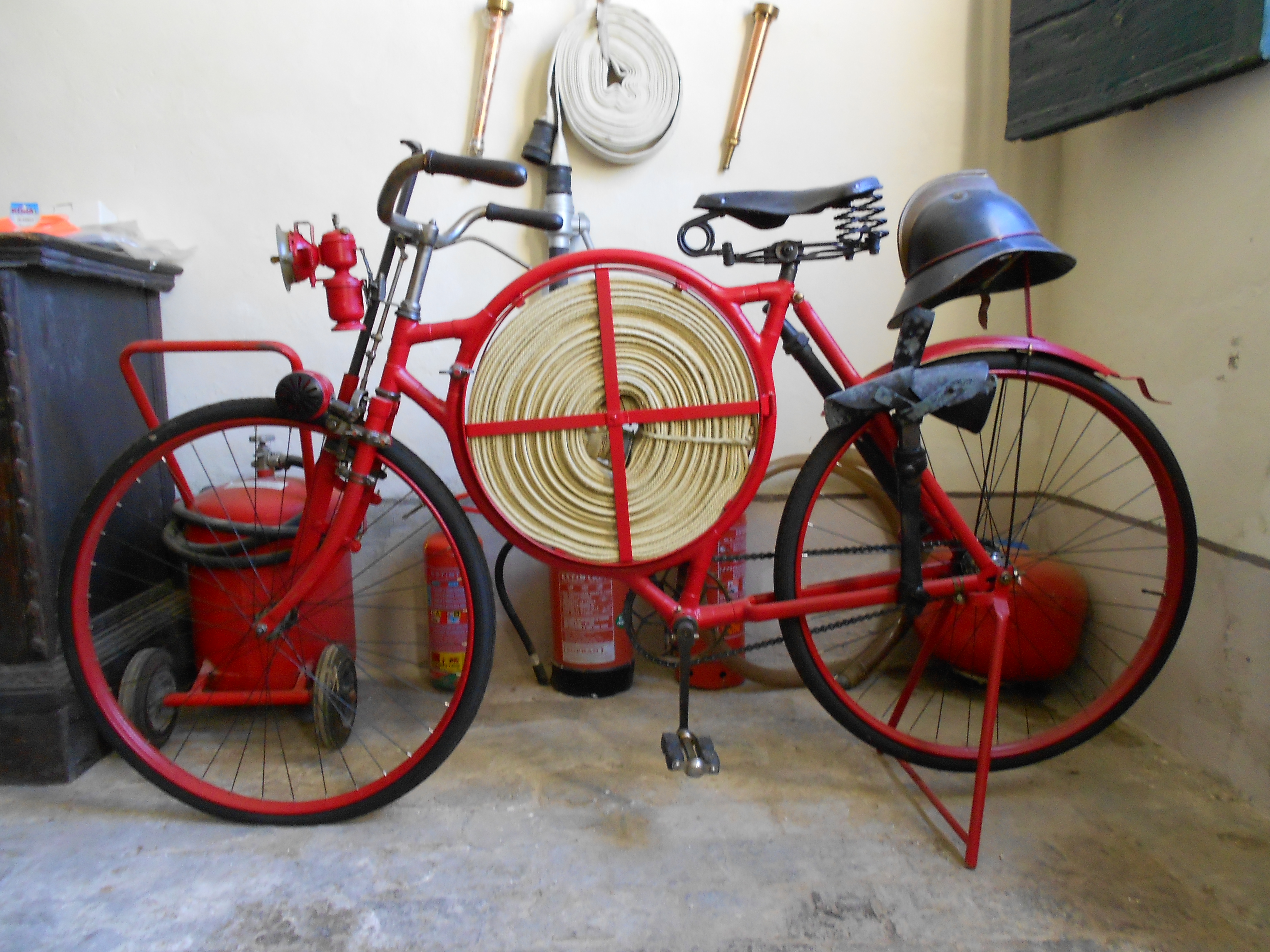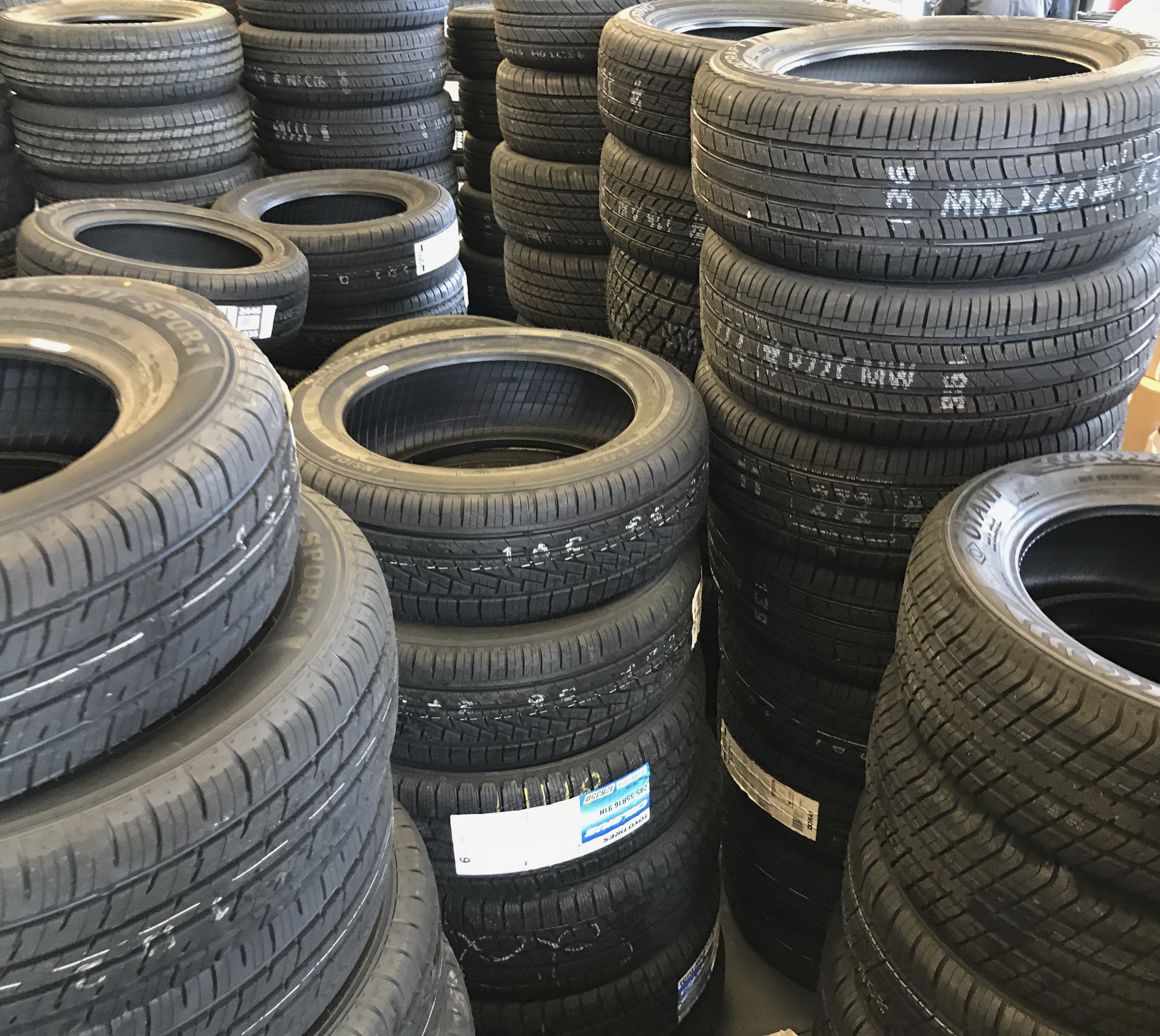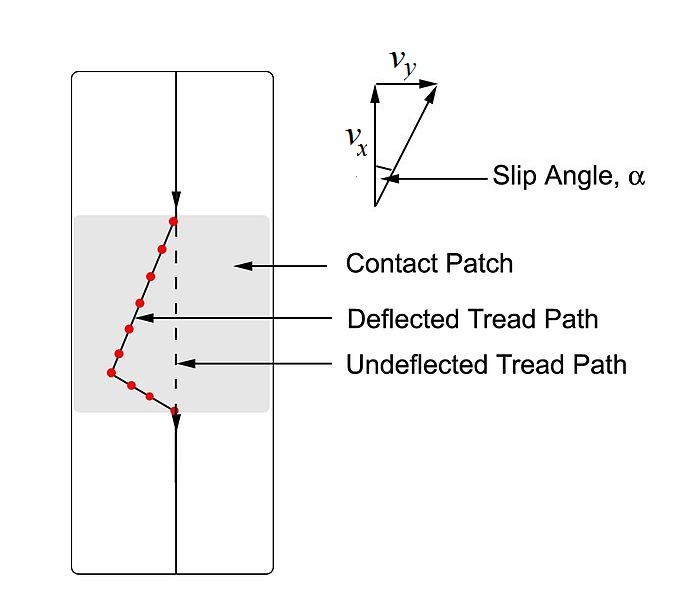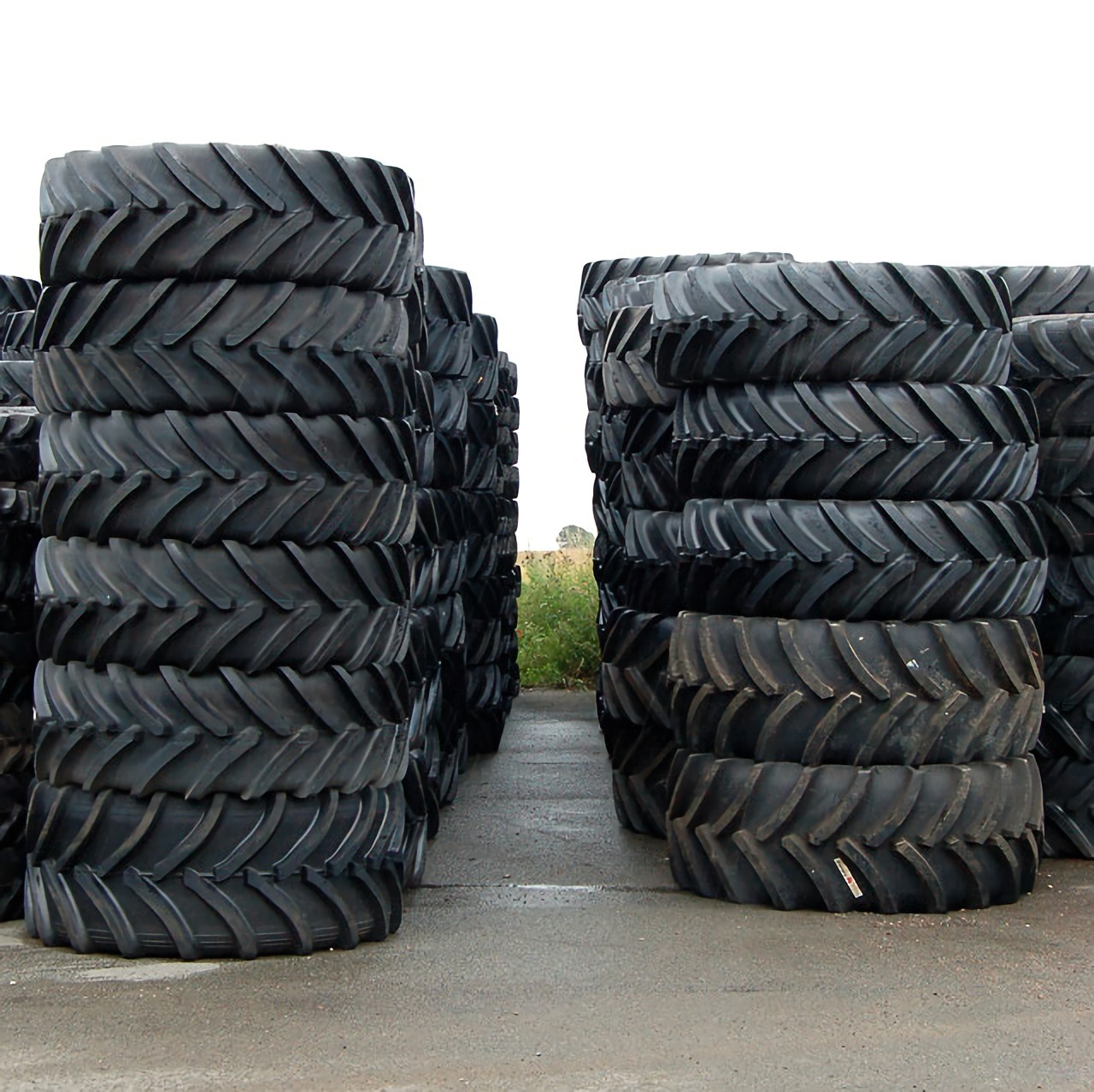|
Relaxation Length
Relaxation length is a property of pneumatic tires that describes the delay between when a slip angle is introduced and when the cornering force reaches its steady-state value. It is also described as the distance that a tire rolls before the lateral force builds up to 63% of its steady-state value. It can be calculated as the ratio of ''cornering stiffness'' over the ''lateral stiffness'', where cornering stiffness is the ratio of cornering force over slip angle, and lateral stiffness is the ratio of lateral force over lateral displacement. Values Pacejka gives a rule of thumb that "at nominal vertical load the relaxation length is of the order of magnitude of the wheel radius". Relaxations lengths have been found to be between 0.12 and 0.45 meters, with higher values corresponding to higher velocities and heavier loads. Tests on motorcycle tires have found that the ratio of cornering stiffness over lateral stiffness produces values 20-25% higher than those calculated as 63 ... [...More Info...] [...Related Items...] OR: [Wikipedia] [Google] [Baidu] |
Bicycle Tire Lateral Force Vs Distance Rolled
A bicycle, also called a pedal cycle, bike, push-bike or cycle, is a human-powered or motor-assisted, pedal-driven, single-track vehicle, with two wheels attached to a frame, one behind the other. A is called a cyclist, or bicyclist. Bicycles were introduced in the 19th century in Europe. By the early 21st century there were more than 1 billion bicycles. There are many more bicycles than cars. Bicycles are the principal means of transport in many regions. They also provide a popular form of recreation, and have been adapted for use as children's toys. Bicycles are used for fitness, military and police applications, courier services, bicycle racing, and artistic cycling. The basic shape and configuration of a typical upright or "safety" bicycle, has changed little since the first chain-driven model was developed around 1885. However, many details have been improved, especially since the advent of modern materials and computer-aided design. These have allowed fo ... [...More Info...] [...Related Items...] OR: [Wikipedia] [Google] [Baidu] |
Pneumatic Tire
A tire (North American English) or tyre (Commonwealth English) is a ring-shaped component that surrounds a wheel's rim to transfer a vehicle's load from the axle through the wheel to the ground and to provide traction on the surface over which the wheel travels. Most tires, such as those for automobiles and bicycles, are pneumatically inflated structures, providing a flexible cushion that absorbs shock as the tire rolls over rough features on the surface. Tires provide a footprint, called a contact patch, designed to match the vehicle's weight and the bearing on the surface that it rolls over by exerting a pressure that will avoid deforming the surface. The materials of modern pneumatic tires are synthetic rubber, natural rubber, fabric, and wire, along with carbon black and other chemical compounds. They consist of a tread and a body. The tread provides traction while the body provides containment for a quantity of compressed air. Before rubber was developed, tires were ... [...More Info...] [...Related Items...] OR: [Wikipedia] [Google] [Baidu] |
Slip Angle
In vehicle dynamics, slip angle or sideslip angle is the angle between the direction in which a wheel is pointing and the direction in which it is actually traveling (i.e., the angle between the forward velocity vector v_x and the vector sum of wheel forward velocity v_x and lateral velocity v_y, as defined in the image to the right). This slip angle results in a force, the cornering force, which is in the plane of the contact patch and perpendicular to the intersection of the contact patch and the midplane of the wheel. This cornering force increases approximately linearly for the first few degrees of slip angle, then increases non-linearly to a maximum before beginning to decrease. The slip angle, \alpha is defined as \alpha \triangleq -\arctan\left(\frac\right) Causes A non-zero slip angle arises because of deformation in the tire carcass and tread. As the tire rotates, the friction between the contact patch and the road results in individual tread 'elements' (finite s ... [...More Info...] [...Related Items...] OR: [Wikipedia] [Google] [Baidu] |
Cornering Force
Cornering force or side force is the lateral (i.e., parallel to wheel axis) force produced by a vehicle tire during cornering. Cornering force is generated by tire slip and is proportional to slip angle at low slip angles. The rate at which cornering force builds up is described by relaxation length. Slip angle describes the deformation of the tire contact patch, and this deflection of the contact patch deforms the tire in a fashion akin to a spring. As with deformation of a spring, deformation of the tire contact patch generates a reaction force in the tire; the cornering force. Integrating the force generated by every tread element along the contact patch length gives the total cornering force. Although the term, "tread element" is used, the compliance in the tire that leads to this effect is actually a combination of sidewall deflection and deflection of the rubber within the contact patch. The exact ratio of sidewall compliance to tread compliance is a factor in ... [...More Info...] [...Related Items...] OR: [Wikipedia] [Google] [Baidu] |
Time Constant
In physics and engineering, the time constant, usually denoted by the Greek language, Greek letter (tau), is the parameter characterizing the response to a step input of a first-order, LTI system theory, linear time-invariant (LTI) system.Concretely, a first-order LTI system is a system that can be modeled by a single Ordinary differential equation, first order differential equation in time. Examples include the simplest single-stage electrical RC circuit#Series circuit, RC circuits and RL circuit#Series circuit, RL circuits. The time constant is the main characteristic unit of a first-order LTI system. It gives speed of the response. In the time domain, the usual choice to explore the time response is through the step response to a Heaviside step function, step input, or the impulse response to a Dirac delta function input. In the frequency domain (for example, looking at the Fourier transform of the step response, or using an input that is a simple sinusoidal function of time) ... [...More Info...] [...Related Items...] OR: [Wikipedia] [Google] [Baidu] |
Motorcycle Tire
A motorcycle tyre (spelt tire in American English) is the outer part of motorcycle wheel, attached to the rim, providing traction, resisting wear, absorbing surface irregularities, and allowing the motorcycle to turn via countersteering. The two tyres' contact patches are the motorcycle's connection to the ground, and so are fundamental to the motorcycle's suspension behaviour, and critically affect safety, braking, fuel economy, noise, and rider comfort. History The history of motorcycle tyres is a clear progression of steady improvement in grip, allowing better acceleration, braking, and turning, along with improved comfort, safety, durability, and reliability. This progression has generally meant a steady increase in tyre width, so much so that Kevin Cameron noted the assumption among riders that "bigger must be better in every way", leading to, "the temptation to overwhelm motorcycles with the biggest tyres the owner can find." While many advances in tyre materials and c ... [...More Info...] [...Related Items...] OR: [Wikipedia] [Google] [Baidu] |
Camber Thrust
Camber thrust and camber force are terms used to describe the force generated perpendicular to the direction of travel of a rolling tire due to its camber angle and finite contact patch. Camber thrust is generated when a point on the outer surface of a leaned and rotating tire, that would normally follow a path that is elliptical when projected onto the ground, is forced to follow a straight path while coming in contact with the ground, due to friction. This deviation towards the direction of the lean causes a deformation in the tire tread and carcass that is transmitted to the vehicle as a force in the direction of the lean. Camber thrust is approximately linearly proportional to camber angle for small angles, reaches its steady-state value nearly instantaneously after a change in camber angle, and so does not have an associated relaxation length. Bias-ply tires have been found to generate more camber thrust than radial tires. Camber stiffness is a parameter used to describe the ... [...More Info...] [...Related Items...] OR: [Wikipedia] [Google] [Baidu] |
Speed Wobble
Speed wobble (also known as shimmy, tank-slapper, or death wobble) is a rapid side-to-side shaking of a vehicle's wheel(s) that occurs at high speeds and can lead to loss of control. It presents as a quick (4–10 Hz) oscillation of primarily the steerable wheel(s), and is caused by a combination of factors, including initial disturbances and insufficient damping, which can create a resonance effect. Initially, the rest of the vehicle remains mostly unaffected, until translated into a vehicle yaw oscillation of increasing amplitude, producing loss of control. Vehicles that can experience this oscillation include motorcycles and bicycles, skateboards, and, in theory, any vehicle with a single steering pivot point and a sufficient amount of freedom of the steered wheel, including that which exists on some light aircraft with tricycle gear where instability can occur at speeds of less than ; this does not include most automobiles. The initial instability occurs mostly at h ... [...More Info...] [...Related Items...] OR: [Wikipedia] [Google] [Baidu] |
Bicycle And Motorcycle Dynamics
Bicycle and motorcycle dynamics is the science of the motion of bicycles and motorcycles and their components, due to the forces acting on them. Dynamics falls under a branch of physics known as classical mechanics. Bike motions of interest include balancing, steering, braking, accelerating, suspension activation, and vibration. The study of these motions began in the late 19th century and continues today. Bicycles and motorcycles are both single-track vehicles and so their motions have many fundamental attributes in common and are fundamentally different from and more difficult to study than other wheeled vehicles such as dicycles, tricycles, and quadracycles. As with unicycles, bikes lack lateral stability when stationary, and under most circumstances can only remain upright when moving forward. Experimentation and mathematical analysis have shown that a bike stays upright when it is steered to keep its center of mass over its wheels. This steering is usually supplied b ... [...More Info...] [...Related Items...] OR: [Wikipedia] [Google] [Baidu] |
Pneumatic Trail
Pneumatic trail or trail of the tire is a trail-like effect generated by compliant tires rolling on a hard surface and subject to side loads, as in a turn. More technically, it is the distance that the resultant force of side-slip occurs behind the geometric center of the contact patch. Causes Pneumatic trail is caused by the progressive build-up of lateral force along the length of the contact patch, such that lateral forces are greater towards the rear of the contact patch (though less so when the rear of the contact patch begins sliding) and this creates a torque on the tire called the self aligning torque. Because the direction of the side-slip is towards the outside of a turn, the force on the tire is towards the center of the turn. Therefore, this torque tends to turn the front wheel in the direction of the side-slip, away from the direction of the turn. Variation Pneumatic trail is at its maximum when the slip angle is zero and decreases as slip angle increases. Pneumatic ... [...More Info...] [...Related Items...] OR: [Wikipedia] [Google] [Baidu] |
Vehicle Dynamics
Vehicle dynamics is the study of vehicle motion, e.g., how a vehicle's forward movement changes in response to driver inputs, propulsion system outputs, ambient conditions, air/surface/water conditions, etc. Vehicle dynamics is a part of engineering primarily based on classical mechanics. It may be applied for motorized vehicles (such as automobiles), bicycles and motorcycles, aircraft, and watercraft. Factors affecting vehicle dynamics The aspects of a vehicle's design which affect the dynamics can be grouped into drivetrain and braking, suspension and steering, distribution of mass, aerodynamics and tires. Drivetrain and braking * Automobile layout (i.e. location of engine and driven wheels) * Powertrain * Braking system Suspension and steering Some attributes relate to the geometry of the suspension, steering and chassis. These include: * Ackermann steering geometry * Axle track * Camber angle * Caster angle * Ride height * Roll center * Scrub radius * Stee ... [...More Info...] [...Related Items...] OR: [Wikipedia] [Google] [Baidu] |
Tires
A tire (North American English) or tyre (Commonwealth English) is a ring-shaped component that surrounds a wheel's rim to transfer a vehicle's load from the axle through the wheel to the ground and to provide traction on the surface over which the wheel travels. Most tires, such as those for automobiles and bicycles, are pneumatically inflated structures, providing a flexible cushion that absorbs shock as the tire rolls over rough features on the surface. Tires provide a footprint, called a contact patch, designed to match the vehicle's weight and the bearing on the surface that it rolls over by exerting a pressure that will avoid deforming the surface. The materials of modern pneumatic tires are synthetic rubber, natural rubber, fabric, and wire, along with carbon black and other chemical compounds. They consist of a tread and a body. The tread provides traction while the body provides containment for a quantity of compressed air. Before rubber was developed, tires wer ... [...More Info...] [...Related Items...] OR: [Wikipedia] [Google] [Baidu] |








